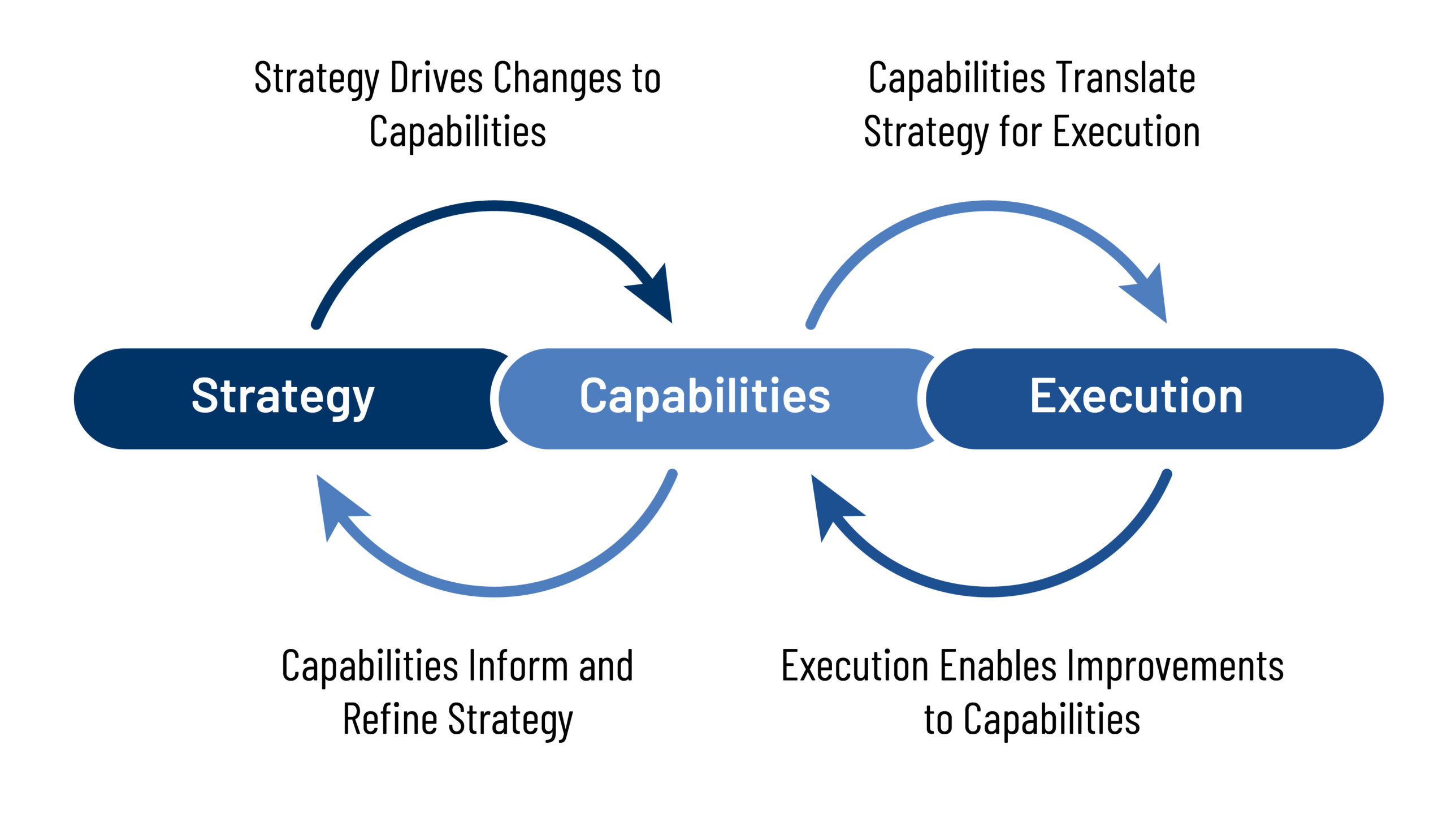What does it take to succeed with digital transformation, or conversely, to fail without it? Factors such as a well-defined vision and strategy, strong leadership support, effective change management, prioritizing customer needs, cultivating digital expertise, robust data management and governance, ensuring security and compliance, and other critical elements are often at the forefront of this discussion.
However, there is often minimal focus on the fundamental ability that underpins digital transformation: the capacity to adapt and change. The volume and pace of change resulting from technology, disruption, and other factors demands it. Effective strategy execution gives organizations the capacity to adapt and change, and it lies at the heart of successful transformations. Even the most brilliant digital strategy or business model becomes irrelevant if an organization cannot execute it effectively.
The ability to translate strategy into reality, and constantly innovate and adapt to change, has now become a competitive advantage. The organizations that can execute in a coordinated way – and with agility – will be the ones that survive and thrive.
Executing Strategy Well is a Challenge for Most Organizations.
However, statistics abound that underscore how challenged most organizations are to execute strategy well. There are several primary root causes that contribute to ineffective strategy execution:
- Fragmented Strategy to Execution Function – In many organizations, strategy execution is not perceived or treated as a cohesive function or process. Rather, the activities involved, from strategy development to delivery, are dispersed across various functions and disciplines, lacking central accountability for business outcomes.
- Lack of Coordination in Translating Strategy – Often, strategy gets translated within organizational silos, resulting in exhaustive lists of initiatives and solutions that may or may not add up to deliver on the organization’s intended outcomes. This approach can lead to redundant solutions, disjointed experiences, misaligned investments, and an accumulation of technical debt and complexity.
- Educational Gap – A recent study of graduate business schools highlighted that there is a lack of emphasis on teaching future business leaders how to execute strategy[i], which is a critical skill for organizational success.
The Institute for Digital Transformation suggests that most industry analysts place the failure rate for digital transformations between 70% and 85%.[ii] Organizations that are challenged to execute strategy well will be equally challenged to succeed with transformation. Transformation requires the exact same process for the continual translation of business direction into coordinated action across business units, products, and geographies. An effective end-to-end process from strategy to execution is essential to succeed with digital transformation.
What is Successful Strategy Execution?
Successful strategy execution is the ability to define clear strategic intent and then translate it into organized effort across people, processes, information, and technology. It requires a fundamental shift in how we perceive and enact strategic change, moving beyond delivering isolated initiatives to formulating a cohesive response to strategy. Organizations equipped with the following key abilities will think and work in ways that ultimately produce effective strategy execution outcomes.
Comprehensive Approach to Strategy Execution. Successful organizations operate with a cohesive, end-to-end process from strategy to execution, with clearly defined integration across all functions and disciplines. This includes intentional change management, transparency throughout the process, and overall accountability for the business outcomes delivered.
Clearly Defined Strategy. A robust strategy clearly articulated is the cornerstone for successful strategy execution. Effective organizations leverage a shared framework to decompose and align business direction into well-defined focal points that help organize the strategy discussion. Strategy needs to be a living and breathing reference point that everyone in an organization understands and can contribute to.
Leverage Shared Business Building Blocks. Formulating a cohesive response to strategy relies on shared business building blocks, typically business capabilities and value streams. Strategy is built upon capabilities. Capabilities help organizations to concentrate their resources on the things that will help them to win and coordinate changes across people, processes, information, and technology. In addition, capabilities also help to synergize business and technology solution investment and design around capabilities to ensure modularity, reuse, and consistency across value streams and stakeholder journeys.
Continual Response Mechanism. Given the pace of change, strategy formulation and execution have become inextricably linked. Successful organizations dynamically sense and respond to their environment, much like a living organism’s reflex to its environment. These organizations adapt their strategies and goals when internal and external conditions evolve, dynamically replanning investments in capabilities and initiatives accordingly.
The diagram below illustrates the continual response mechanism, depicting capabilities as a bridge between strategy and execution, synchronizing changes across people, processes, information, and technology to attain a desired future state.

Intentional Organizational Design. Ultimately, successfully bridging the gap between strategy and execution relies on the intentional and holistic design of an organization. This design does not happen by chance, and it requires the collaboration across many different design disciplines. It involves deliberate business decision-making about experiences, structures, culture, capabilities, value streams and processes, and technology. Successful organizations share a comprehensive understanding of their business that not only reflects the organization today, but designs it for agility and resilience, enabling evolution and growth in the future.
Moving Into Action
How do we put these ideas into practice? A comprehensive approach to strategy execution introduces new ways of thinking and working across an organization, so this is a journey that takes time. However, transformation offers an ideal opportunity to establish a unified, end-to-end practice from strategy to execution and gradually implement it.
Here are a few steps you can take:
- Assess your organization’s current strategy to execution approach and the effectiveness in delivering outcomes.
- Start conversations: create an intolerance for status quo, explore the possibilities, and build a compelling case for change.
- Establish a foundation in business architecture to define the reusable business building blocks of the capabilities and value streams. Scale and mature the discipline within your organization over time.
- Start making forward progress – one person, one step, and one win at a time. Choose a starting point such as incorporating an enterprise perspective into investment decision-making or strategy translation.
- Serve as an advocate to help facilitate change: your voice and your leadership are crucial.
Simply stated, to succeed with transformation, organizations must build a cohesive, end-to-end capacity for strategy execution. Strategy execution should be treated with the same importance as any other critical function of an organization such as product development, sales, marketing, or customer care. Successful strategy execution allows organizations to get new business direction and products/services to market much quicker, and ultimately can lead to competitive advantage. It also equips organizations with the essential agility to continually adapt to change, ensuring they can thrive in the evolving landscape of the future.
[i] Please see the study by the Graduate Business Curriculum Roundtable on Strategy Execution in Graduate Management Education
[ii] Please see specific statistics within the Digital Transformations Fail! section
Tag/s:ArchitectureBusiness TransformationDigital Enterprise





